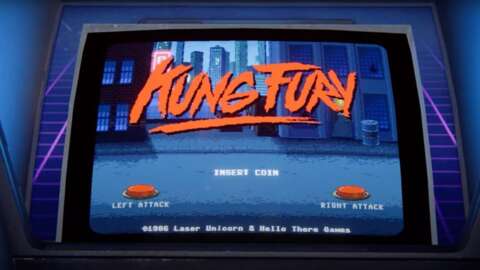Four Ways You Can Make Steam Better Right Now
Steam isn't the most modern storefront out there, but you can make it work better with a few tweaks.
If you're a PC gamer, you've probably enjoyed the chaotic scramble of Steam sales, or scrolling through your recommendations in search of your next favorite game. However, while most of us appreciate Steam--or at least tolerate it, given that it's an unavoidable part of the PC gaming landscape--Valve's venerable storefront can often seem a bit clunky compared to the more modern interfaces we use in our daily lives.
Though you can't fully erase Steam's peculiarities, there are a few ways to shape it more to your tastes. If you're tired of flat-black backgrounds and your game library presenting as an imposing wall of titles, you can add a little bit of customization. Many of these tricks are buried in Steam's somewhat-confusing options menu, but there are still a few tweaks that we'd recommend to make Steam look and feel better.
Categorizing your games
Steam's default game library display settings aren't to my taste. The list is too small, the game detail pane too big, and there's a lot of dark negative space that you have to scroll through to do anything. The good news is that this is by far the most customizable part of the Steam experience, and it doesn't take much effort to fix some of its more glaring flaws.
If you aren't using Steam's game collection function already, you really should. The collection feature lets you organize and sort your games into groups based on many different criteria, rather than the usual alphabetized list. This makes it easier to navigate through your library. It might seem like an insignificant feature, but it can have an outsized impact on your gaming time. To make a new collection on Steam, click the four boxes next to the Home tab, then click "create a new collection." You have two options: making a normal collection, or a dynamic collection. We're sticking to normal collections for now.
To add a game to a collection, simply highlight it, right-click, go to "add to," and select the collection you want. You can use usual Windows commands like Shift or Ctrl-click in order (or Shift + arrow keys) to highlight many games at once, which will save a lot of time. Keep in mind that a game can belong to multiple collections at once.
While the collections you make are ultimately up to you, I recommend at least five: "Currently Playing," "Will Play," "Finished," "Favorites," and, most crucially, "Not Interested." Personally, I split my "Will Play" category into three tiers of enthusiasm, and my favorites by multiplayer and single-player games, but there's no right way to do it.
On the subject of game categories, don't forget that you can easily set Steam to show only games that you have currently installed by clicking the play arrow next to Games and Software. Additionally, if you click the clock next to it, you'll sort all of your games by recent activity.
Dynamic collections
Dynamic collections are an underrated (and perhaps unknown) aspect of Steam's categorization system. The main draw here is that these collections update themselves without any input from you. This makes them particularly useful for tracking traits that change over time, particularly playtime, recent friend activity, and Steam review score. You can also set them track Steam tags that mark genre, tone, and length, so if you want to play all of the roguelikes or horror games you own, this is an easy way to do it.
If you have a game collection so large that you often forget what you own, dynamic collections are a great way to jog your memory, or simply decide on a game to play. They don't take much time to set up, either.
Changing skins
So you've messed around with Steam's default visual settings, and you've decided you want something a little different. The good news is that installing a new Steam skin to change the entire program's look is really quite easy. The bad news is that they're surprisingly limited in functionality these days.
To install a Steam skin, you need to make a new folder in your Steam directory, called "skins." Then, you can download the skin you want and extract its data in that folder. Make sure it has its own subfolder. Then, go to Steam's settings, then Interface, and select the skin from the drop-down menu. The most popular Steam skins are Metro, Plexed, and Compact. Metro is the easiest one to get working, so I recommend it. Personally, however, I use OG-Steam, which transforms the client into its very first version from way back in 2004. SteamSkins.org is the best site to find many Steam skins.
While these skins can change the appearance of the Steam client's outer edges, that's pretty much all they can do. Why? Because Steam has switched almost all of its functionality to be browser-based over the past few years. If you want to skin your Steam Library and Friend tabs, you can download a third-party program called SFP (formerly SteamFriendsPatcher) to patch over the default CSS. However, it can be a bit finicky to work with. If you want to learn more about how you can maximize your utility with Steam skins, check out this guide.
Try an alternative game manager
From an objective standpoint, Steam doesn't offer a lot of options to aesthetically-focused consumers. You can get around its limitations by using other game management sofware instead. These programs allow you to easily launch games from multiple digital platforms, such as Steam and Epic Games, from one place. f you still want an all-in-one game launcher that fits this bill, we recommend Playnite.
While Playnite still does require you to have Steam (and other storefronts) open in order to play your library on that platform, its default theme looks a lot better than Valve's program. It supports emulators and standalone games as well, complete with info from online databases, as well as an hour counter. It also supports quite a few snazzy-looking themes. If you'd prefer to stick to an official platform, GOG Galaxy 2.0 is also an option, as it allows you to add games to the launcher that aren't on the GOG storefront or platform, like your Steam games.
Sticking to actual gaming storefronts like Epic Games and Steam makes it easier to keep track of new games, as well as sales. By contrast, unofficial platforms like Playnite are much more customizable and aesthetically-focused.
As a whole, I think a lot of people look at front-ends like Playnite and wonder just what the point is. For most players, custom themes and a few categories are enough to keep the library nice and sorted, and Steam can provide those options. If you're the sort who puts effort into heavily organizing your gaming library and making it look exactly how you want, then it's fair to say that Steam has a ways to go, and other programs might be the solution you're looking for.
Got a news tip or want to contact us directly? Email news@gamespot.com







Join the conversation